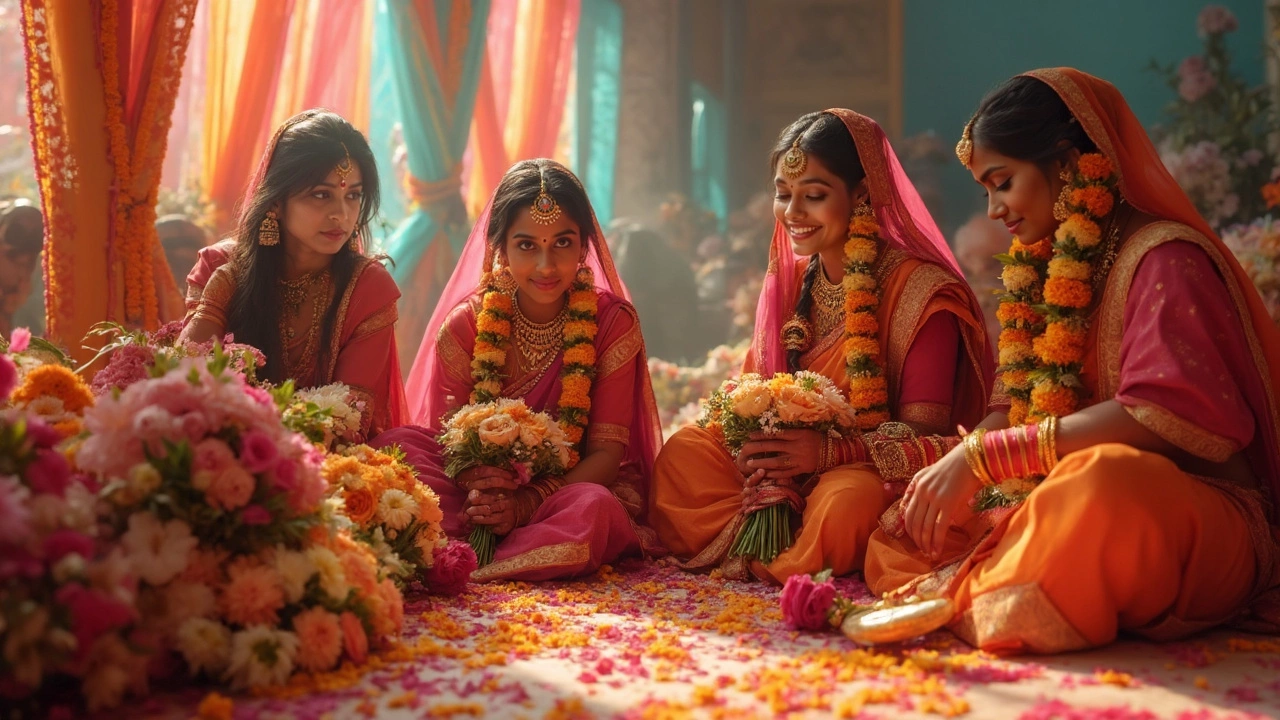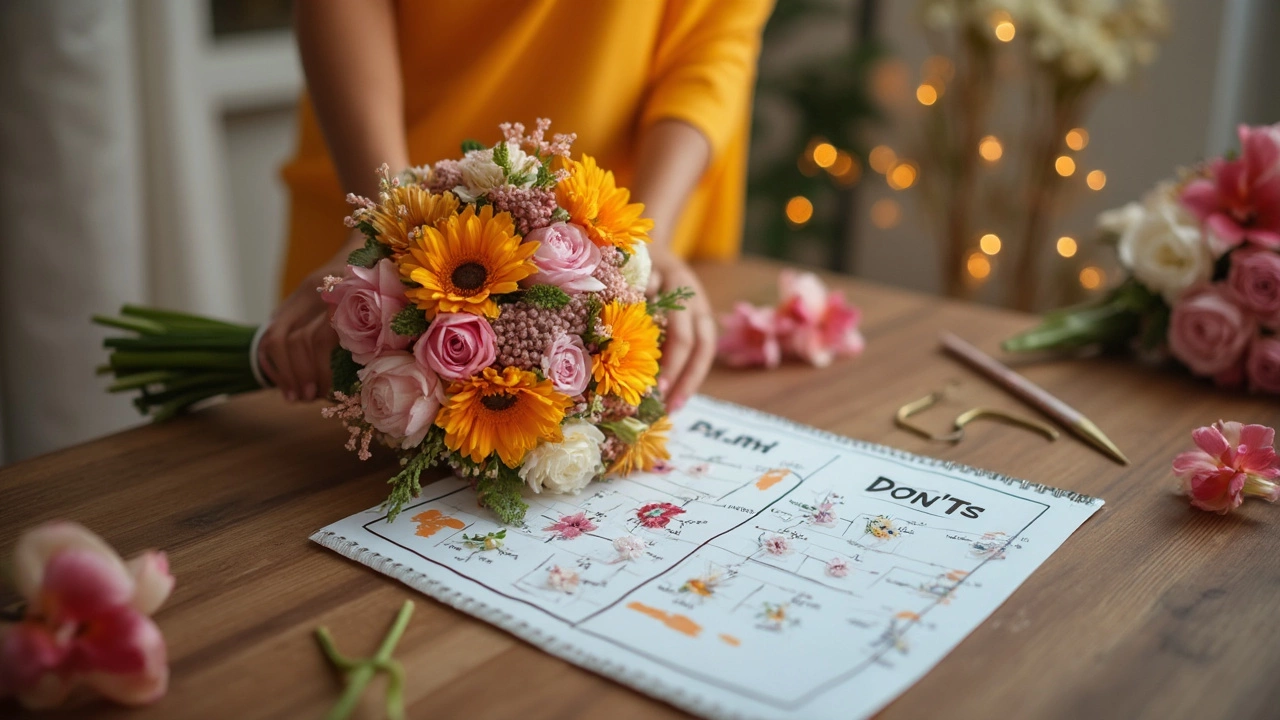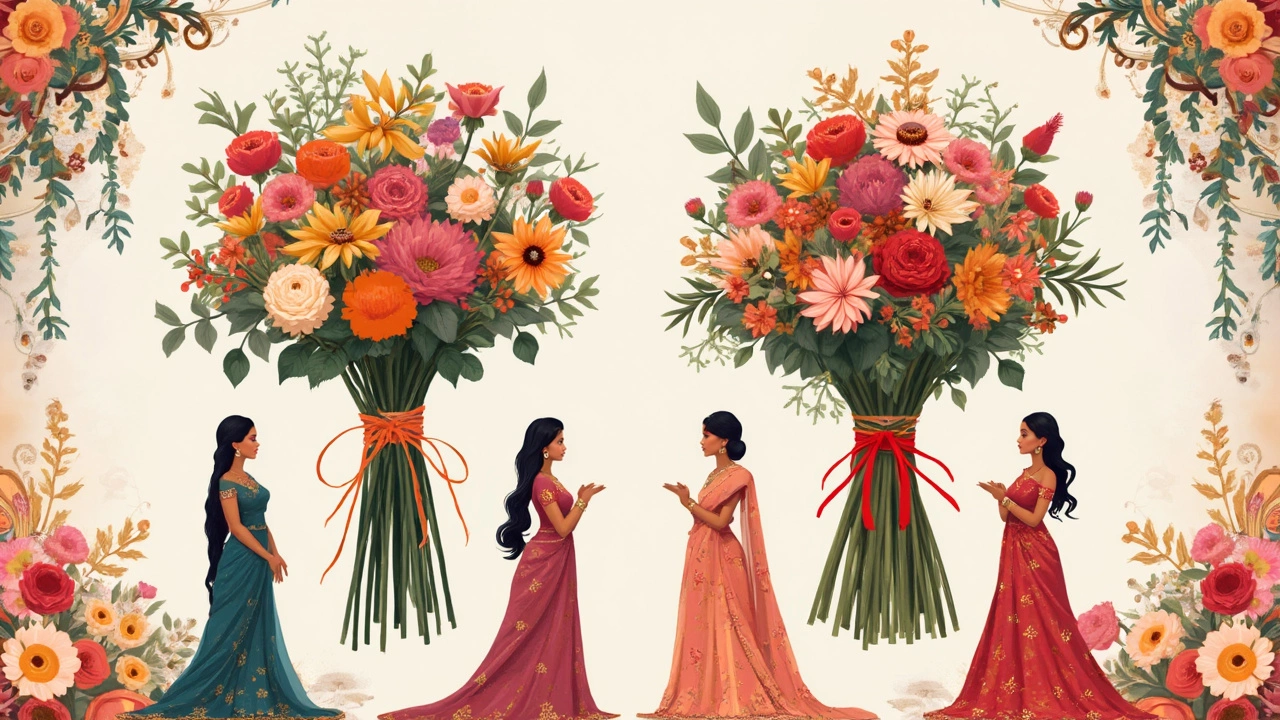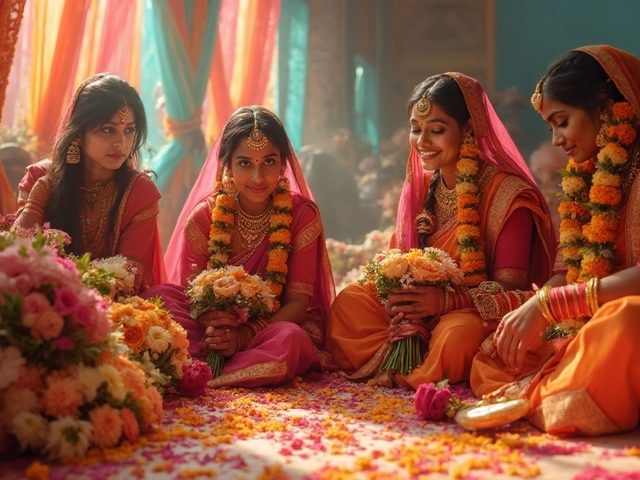
Picture this: Your perfect wedding bouquet is falling apart halfway through the reception, or some blooms look amazing but others are a droopy mess. Mixing flowers isn’t just about color or size—some just can’t be friends in the same vase. Trust me, even seasoned florists have fallen for tricky combos that ended up in disaster.
What's the problem? Some flowers give off chemicals that actually harm others, while certain strong scents can totally overwhelm delicate blooms nearby. Ever seen roses looking sad next to daffodils? That’s not just bad luck—daffodils release sap that makes other blooms wilt faster. Tulips, lilies, and daffodils together? It's a recipe for uneven wilting and less-than-fresh-looking petals by the end of the day.
If you care about your bouquet lasting all day and looking gorgeous in every photo, knowing which flowers just can't go together is a game changer. Ready for some real talk on mixing and matching wedding flowers? There's a bit of science and plenty of florist wisdom behind the perfect match (or mismatch).
- Common Flower Clashes
- Scent Overload and Chemical Incompatibilities
- Wilting Drama: Mixing Long-Lasting and Sensitive Blooms
- Style Mismatches: Formal vs. Wild
- Florist-Proven Winning Combos
Common Flower Clashes
If you've ever seen a bunch of droopy or sad-looking flowers in what should be a gorgeous wedding flowers bouquet, there's a reason. Some blooms just don't play nicely together, and the combo can ruin the whole look. Let's get specific. Daffodils are floral divas—they release a sticky sap that makes just about every other flower wilt faster, especially tulips and roses. Put them in the same bouquet without special prep and you'll be facing a droopy disaster in just a few hours.
It's not just daffodils. Lilies are known for their heavy pollen and strong scent, which can mess with delicate flowers like gardenias or sweet peas. And those big, thirsty hydrangeas? They suck up so much water that your smaller, more delicate stems like anemones will be parched and lifeless by the afternoon. Even cheerful sunflowers can cause trouble: their big, rough stems can damage softer blooms when packed too closely.
If you’re curious about the repeat offenders, check out this table showing the most common flower clash culprits and who they don't get along with:
| Flower | Problematic Pairing | Why They Clash |
|---|---|---|
| Daffodils | Roses, Tulips, Ranunculus | Releases sap that makes others wilt |
| Hydrangeas | Anemones, Poppies | Absorb water too quickly, leaving others dry |
| Sunflowers | Ranunculus, Peonies | Rough stems can crush delicate blooms |
| Asparagus Fern | Lilies, Orchids | Foliage irritates soft petals |
| Gardenias | Lilies, Strong-scented blooms | Competing scents and damaged petals |
Most florists actually use daffodils solo, or let their stems sit in water alone for a few hours before mixing with others—just to avoid that deadly sap. If you're determined to have lilies and gardenias, keep them separated or use them in different parts of your arrangement. The basic tip: If you're unsure, always ask if your dream flowers actually play nice, or they could turn on each other before the wedding cake is cut.
Scent Overload and Chemical Incompatibilities
Not all pretty flowers play nice when it comes to scent or chemistry, and this can totally backfire, especially with wedding flowers you want to last all day. Some blooms are just too powerful in the aroma department. If you throw gardenias, jasmine, lilies, and lilacs into one bouquet, it can quickly turn from wow to "Whoa, that's intense!" Overpowering scents cause headaches or even allergies for some guests, and they drown out the softer, subtler notes of filler flowers you might really want to be noticed.
Chemical incompatibilities are a sneakier problem. A classic example is mixing daffodils with, well, just about anything else. Daffodils release a chemical in their stem sap that makes plenty of other flowers wilt or die off faster. Carnations, roses, and tulips all get hit hard if you stick them in the same water as freshly cut daffodils. The fix? If you’re set on daffodils, let them sit by themselves in water for 24 hours, then add them to your bouquet—just avoid recutting the stems, or the sap comes out again.
Some flowers, like lilies and hyacinths, also give off their own mix of chemicals—sometimes these don’t play well with the more delicate stems like gerberas or freesias. Ask your florist; they’ll probably avoid pairing these unless you really push for it.
| Flower | Reason to Avoid in Mixed Bouquets |
|---|---|
| Daffodil | Releases toxic sap—shortens life of other flowers |
| Lily | Very strong scent, can cause allergies and mask lighter flowers’ aroma |
| Hyacinth | Scent overwhelms, sap may reduce vase life of other flowers |
| Gardenia | Scenty, wilts quickly near stronger-stemmed flowers |
Tips? Want to play it safe with scents and chemistry:
- Leave heavy-scented flowers out of main table bouquets if guests will sit close to them.
- Put similarly-scented (or unscented) blooms together for balance.
- If you love a bold bloom, use it as a "spotlight" rather than the bouquet's backbone.
- Don’t mix daffodils fresh-cut with other favorites—let them sit solo first.
- If you test the vase combo at home, you’ll catch problems before the big day.
Choosing flowers with compatible scents and chemistry isn’t hard once you know what to avoid. Your bouquet will last longer and people will thank you for the breathing room!

Wilting Drama: Mixing Long-Lasting and Sensitive Blooms
If you mix tough-as-nails flowers with drama queens, your bouquet will start looking sad fast. Picking wedding flowers isn't just about what looks cute; you want a mix that survives all the hugs, photos, and dancing. The biggest issue? Some blooms have totally different life spans, and some start to collapse hours after they hit the vase.
For example, carnations, chrysanthemums, and orchids are strong players—they’ll last days without flinching. On the flip side, gardenias, sweet peas, and poppies get floppy quick, especially in heat or without constant water. If you pair these together, you’re just asking for half your bouquet to crash early, while the rest looks fine.
Mismatched vase life isn’t the only problem. Some sensitive flowers, like anemones and hydrangeas, suck up water like crazy. If you don’t keep an eye on them, they’ll steal all the moisture, leaving sturdy flowers surprisingly dry. There’s also the classic no-no: never combine daffodils with anything else. Daffodils ooze a sap that speeds up wilting for every flower around them.
Here's a breakdown of how long some common wedding blooms last. This will give you a sense of what to mix (or not):
| Flower | Average Vase Life | Wilting Risk |
|---|---|---|
| Carnations | 10-14 days | Low |
| Orchids | 7-14 days | Low |
| Roses | 5-7 days | Medium |
| Hydrangeas | 3-5 days | High |
| Gardenias | 1-2 days | Very High |
| Poppies | 1-2 days | Very High |
If you want a sturdy bouquet, keep these tips in mind:
- Stick with blooms that have similar vase lives for your wedding flowers.
- If you can't resist fragile flowers, keep them in their own little arrangement or just use a few blooms as accents.
- Prep stems carefully—condition them in water for hours before arranging.
- Avoid flowers that leak sap (like daffodils and hyacinths) unless they're alone in a vase.
- Ask your florist about sneaky wilters—they’ll know which ones are tricky.
Don’t let your bouquet be a gamble. A smart mix means beautiful blooms from the first photo to the last dance.
Style Mismatches: Formal vs. Wild
Mixing formal and wildflowers might sound cool, but it often leads to a bouquet that just doesn't work. Think of it like wearing a ballgown with hiking boots—it draws attention, but not in a way you’ll want in your wedding photos. Formal flowers (like roses, orchids, or calla lilies) are usually neat, symmetrical, and super polished. Wildflowers (like daisies, thistles, or Queen Anne’s lace) have a relaxed, messy vibe. Jam them together, and the result can look like you couldn't decide on a theme.
Florists say one of the biggest mistakes people make is ignoring vibes. Liz Johnson, a seasoned wedding florist, puts it this way:
"A well-designed bouquet tells one story. Mixing structured, luxury blooms with loose, rustic flowers can feel confusing or chaotic, especially in wedding arrangements."
Let’s break down specific combos that usually don’t work:
- Wedding flowers like peonies with sunflowers. Peonies give major formal garden energy. Sunflowers? Totally farmhouse and casual.
- Classic white orchids with cornflowers or bachelor’s buttons. Orchids are posh; cornflowers are laid-back.
- Sharp, regal tulips with tangled wildflower mixes. The tulips get lost and the bouquet loses any clear shape.
Diving into the stats, a recent survey by WeddingWire found that 67% of professional florists recommend sticking to a “style family” for bouquets, especially for weddings. The results of mixing formal and wild blooms? Rarely do they land in ‘masterpiece’ territory.
| Flower Type | Common Pairing Outcome |
|---|---|
| Roses + Daisies | Clashes; roses look too fancy, daisies too simple |
| Calla Lilies + Wild Asters | Asters look messy next to the clean lily lines |
| Orchids + Queen Anne's Lace | Formality upstaged by rustic looseness |
If you love the wild look but want something wedding-appropriate, try a “just-picked” style with all wildflowers or all garden blooms. Want classic glam? Stick to structured choices throughout. Mixing these two worlds can totally confuse the look and steal attention in ways you probably don’t want. Ask your florist for samples or mock-ups before committing—they’ll spot style clashes before you spend real money on them.

Florist-Proven Winning Combos
If you stick with certain pairings that florists swear by, your bouquet will not only look good but also handle the pressure of a big day. The trick is to pick flowers with similar water needs, shape, and life span. Most importantly, avoid combos that mess with each other's freshness. Here’s where florist secrets come in handy.
One classic winning mix is roses, peonies, and ranunculus. They don’t fight over space in the vase and their petals stay crisp together. Plus, their shapes blend smoothly for that lush, rounded wedding bouquet. Garden roses and hydrangeas are another dream team. Just keep them hydrated—both love lots of water, making care simple.
If you’re after soft, romantic vibes, try mixing lisianthus with spray roses and sweet peas. They share similar stem strength and keep each other looking fresh. Proteas and eucalyptus are reliable for modern rustic looks. Eucalyptus lasts forever and doesn’t zap the life from more delicate blooms. Anemones, tulips, and ranunculus can also play nicely together, just avoid flowers like daffodils that release harmful sap.
Here's a handy rundown of florist-backed combos shoppers ask for most:
- Wedding flowers: Roses + peonies + ranunculus
- Garden roses + hydrangeas
- Lisianthus + spray roses + sweet peas
- Sunflowers + dahlias (for a bold, rustic look)
- Protea + eucalyptus + waxflower
- Tulips + anemones + ranunculus
- Calla lilies + roses + stephanotis (great for classic style)
Here’s a tip: check what’s in season and try to pick all your blooms from the same monthly availability. They'll usually share the same needs and look fresher for it. Test the smell too—certain combos like freesia or stock with lilies can uplift a bouquet, but don’t overdo it or you’ll turn your bouquet into a perfume cloud. Always ask your florist what works best with your dream flower, and don’t stress if you need to swap something out—great combos are all about flowers that play nice together and don’t steal each other’s thunder.



Comments
Post Comment